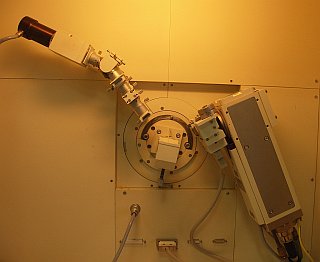A monochromator is an optical device that transmits a mechanically selectable narrow band of wavelengths of light or other radiation chosen from a wider range of wavelengths available at the input. The name is from the Greek roots mono-, single, and chroma, colour, and the Latin suffix -ator, denoting an agent. Diffraction gratings and.
Light containing various wavelengths can be broken down according to the wavelength. White light (containing many wavelengths) entering the monochromator is extracted as green (5nm), red (6nm), or some other monochromatic (single-wavelength) light. The operating principle can be explained by an experiment .

The device is based on the separating capability of refraction (prism) or diffraction (diffraction grating). Typical applications are isolation of a narrow band of radiation from a continuum light . There are numerous configurations by which this may be achieved – only the most common are discussed in this document and includes Plane Grating Systems (PGS) and Aberration . The main goal of a monochromator is to separate and transmit a narrow portion of the optical signal chosen from a wider range of wavelengths available at the input. In the simplest case the monochromator is composed from two slits (entrance and exit) and a dispersion element (prism or diffraction grating ). They are the critical component for many spectral applications since they can be used to create tunable light sources and also to take high precision spectral measurements.
May be factory configured as a monochromator or a spectrograph. Scans in both directions and in nanometers, Ångstroms, microns, wave-numbers, or eV. Change slits on the fly.

Monochromators act as tunable bandpass filters for light. Suitable for fluorescence, radiometry, process control, . The monochromator is used to photograph the Sun and. Grating monochromator : In a grating- monochromator type instrument, the full range of the source-detector combination is scanned by mechanically changing the grating position. In a Fourier-transform instrument, the range available for a single scan is generally limited by the beam-splitter characteristics. True wavelength faster scan time.
In effect, a monochromator produces monochromatic light by removing unwanted wavelengths from the source light beam. The function of the monochromator is to isolate a single atomic resonance line from the spectrum of lines emitted by the hollow cathode lamp. Define monochromator : a device for isolating a narrow portion of a spectrum. The optical setup then functions as a tunable monochromator. Figure shows the common design of the Czerny–Turner monochromator.
The acquisition time for a full spectrum can be long if a wide spectral range is scanned with high resolution and if the detector cannot be very fast, e. Researchers around the world depend on SpectraPro spectrographs and monochromators for a wide variety of spectroscopic applications, including Raman, fluorescence, photoluminescence, microspectroscopy, absorption, emission, and more. Complete your 8kHz Mono collection. Single and double monochromators , high performance guaranteed.
BThas three monochromators : Cu(220), Cu(200) and a double focusing Si(4). Because the (011) zone axis of the latter is perpendicular to the plane of rotation, all permitted silicon reflections of the type hk_k and hkk can be accessed by simply rotating the monochromator. The Mini-Chrom is a manually operated monochromator that utilizes a knob dial for wavelength selection.

Wavelength is read directly in nanometers ( nm) from a . Product information page on the Focus 5X-ray monochromator. The job of a monochromator is to produce a single spectral line from a broadband (multi-wavelength) source. In spectrom- eters, this can be used to collect light from an atomic emission source, like the atomic emission detector, and allow only a specific line to exit.
It can also be used to isolate a single line.